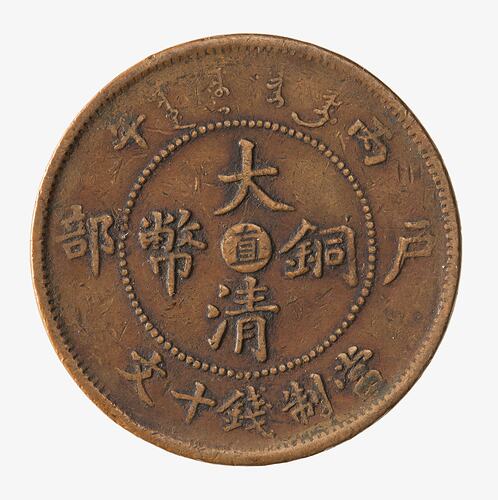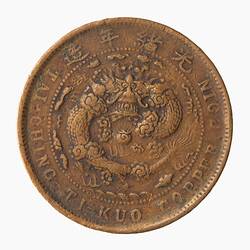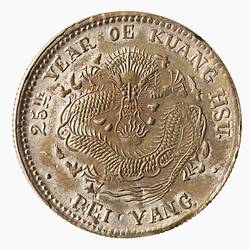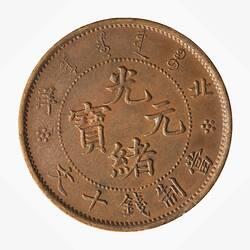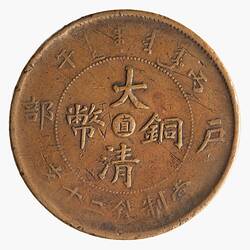Summary
10 Cash, Issued by Chihli (the name of the Provence was changed toHebei (Hopei) in 1928), China, nd. (1906-1910)
Struck at the Peiyang Arsenal mint, Tientsin
Obverse Description
At centre within a circle of beads, four Chinese characters around a raised circle with incuse mint mark; at left and right Chinese characters for 'Board of Revenue'; around above and below, 11 characters
Reverse Description
At centre within a bead circle, a dragon facing, body curved around a pearl; around above, four Chinese characters; around below, TAI-CHING-TI-KUO COPPER COIN
Edge Description
The edge is plain
Significance
The name of the Province, Chihli meant 'directly ruled' (by the Imperial Court) and so was changed in 1928 to Hebei (meaning 'north of the river' in this case meaning the Yellow River).
The mint at the Peiyang Arsenal replaced the Paoting mint which produced cast coins for the Province in 1888. It was upgraded with a silver coin section in 1896 but was destroyed during the Boxer Rebellion (1900-1901) and not re-opened until 1902. On 22 August 1905 the Emperor approved a regulation that would establish a central mint at Tientsin (now Tianjin) with four branch mints at Nanking (now Nanjing), Tientsin, Wuchang and Canton (now Guangzhou). This coin was struck in the new Board of Revenue style which resulted from the Imperial regulation in 1906. Also, under the 1905 regulation, expansion of all other mints was forbidden with an intention to close them when possible. As a result the Peiyang Arsenal mint which was in Tientsin was merged with Teintsin central mint in 1910. The issue is therefore dated between 1906 and 1910.
More Information
-
Collecting Areas
-
Acquisition Information
Transfer from National Gallery of Victoria (NGV), 15 Mar 1976
-
Date Issued
1906-1910 AD
-
Issued By
-
Denomination
-
Series
-
Material
Bronze
-
Axis
12
-
Classification
-
Category
-
Discipline
-
Type of item
-
Dimensions
28 mm (Outside Diameter), 7.36 g (Weight)
-
Shape
Round
-
References
Y#10c
[Book] Bruce, Colin R. 2009. 2009 Standard Catalogue of World Coins 1901 - 2000., 397 Pages
